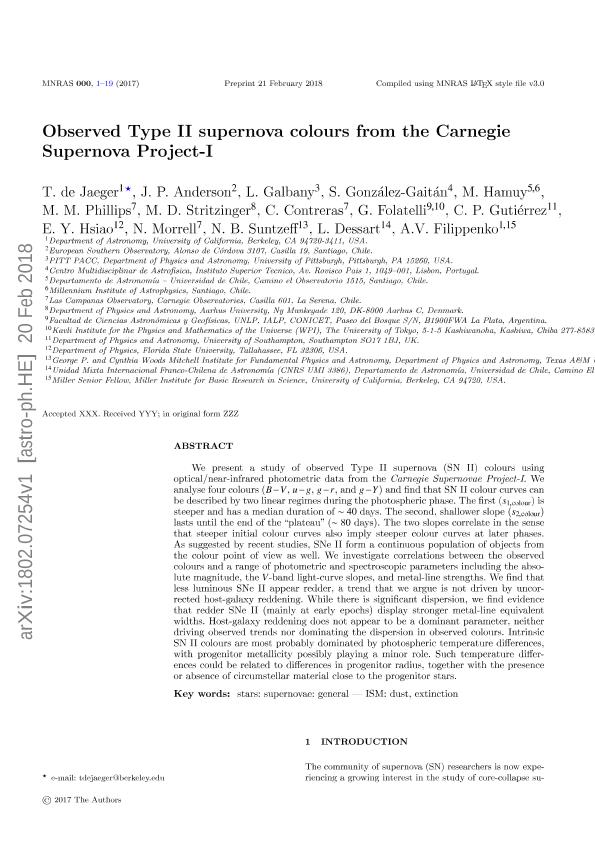Artículo
Observed Type II supernova colours from the Carnegie Supernova Project-I
de Jaeger, T.; Anderson, J. P.; Galbany, L.; González Gaitán, S.; Hamuy, M.; Phillips, M. M.; Stritzinger, M. D.; Contreras, C.; Folatelli, Gaston ; Gutiérrez, C. P.; Hsiao, E. Y.; Morrell, Nidia Irene
; Gutiérrez, C. P.; Hsiao, E. Y.; Morrell, Nidia Irene ; Suntzeff, N. B.; Dessart, L.; Filippenko, A. V.
; Suntzeff, N. B.; Dessart, L.; Filippenko, A. V.
 ; Gutiérrez, C. P.; Hsiao, E. Y.; Morrell, Nidia Irene
; Gutiérrez, C. P.; Hsiao, E. Y.; Morrell, Nidia Irene ; Suntzeff, N. B.; Dessart, L.; Filippenko, A. V.
; Suntzeff, N. B.; Dessart, L.; Filippenko, A. V.
Fecha de publicación:
06/2018
Editorial:
Oxford University Press
Revista:
Monthly Notices of the Royal Astronomical Society
ISSN:
0035-8711
Idioma:
Inglés
Tipo de recurso:
Artículo publicado
Clasificación temática:
Resumen
We present a study of observed Type II supernova (SN II) colours using optical/near-infrared photometric data from the Carnegie Supernovae Project-I. We analyse four colours (B - V, u - g, g - r, and g - Y) and find that SN II colour curves can be described by two linear regimes during the photospheric phase. The first (s, 1colour) is steeper and has a median duration of ~40 d. The second, shallower slope (s, 2colour) lasts until the end of the 'plateau' (~80 d). The two slopes correlate in the sense that steeper initial colour curves also imply steeper colour curves at later phases. As suggested by recent studies, SNe II form a continuous population of objects from the colour point of view as well. We investigate correlations between the observed colours and a range of photometric and spectroscopic parameters including the absolute magnitude, the V-band light-curve slopes, and metal-line strengths. We find that less luminous SNe II appear redder, a trend that we argue is not driven by uncorrected hostgalaxy reddening. While there is significant dispersion, we find evidence that redder SNe II (mainly at early epochs) display stronger metal-line equivalent widths. Host-galaxy reddening does not appear to be a dominant parameter, neither driving observed trends nor dominating the dispersion in observed colours. Intrinsic SN II colours are most probably dominated by photospheric temperature differences, with progenitor metallicity possibly playing a minor role. Such temperature differences could be related to differences in progenitor radius, together with the presence or absence of circumstellar material close to the progenitor stars.
Palabras clave:
Dust
,
Extinction
,
Supernovae: General
Archivos asociados
Licencia
Identificadores
Colecciones
Articulos(IALP)
Articulos de INST.DE ASTROFISICA LA PLATA
Articulos de INST.DE ASTROFISICA LA PLATA
Citación
de Jaeger, T.; Anderson, J. P.; Galbany, L.; González Gaitán, S.; Hamuy, M.; et al.; Observed Type II supernova colours from the Carnegie Supernova Project-I; Oxford University Press; Monthly Notices of the Royal Astronomical Society; 476; 4; 6-2018; 4592-4616
Compartir
Altmétricas



